Front Page News! New York Tribune Archive on Flickr

Women of President Taft’s New Official Family at Washington, New York Tribune, March 7, 1909. Cover, illustrated supplement. Library of Congress image, posted at Flickr. Click to visit webpage.
The Library of Congress has a Flickr album that’s front page news–literally! It’s a New York Tribune archive with newspaper covers dating back more than a century.
“This set of cover pages from the New York Tribune illustrated supplements begins with the year 1909,” explains the album. “The pages are derived from the Chronicling America newspaper resource at the Library of Congress. To read the small text letters, just click the persistent URL to reach a zoomable version of the page.”
“Daily newspapers began to feature pictorial sections in the late 1800s when they competed for readers by offering more investigative exposés, illustrations, and cartoons. In the 1890s, William Randolph Hearst and Joseph Pulitzer tapped into new photoengraving techniques to publish halftone photographs, and other newspapers soon adopted the practice. The heavily illustrated supplement sections became the most widely read sections of the papers and provided a great opportunity to attract new customers. The daily life, art, entertainment, politics, and world events displayed in their pages captured the imagination of a curious public.”

Available at http://genealogygems.com
We don’t often find our ancestors splashed across front-page news. But we can read over their shoulders, as it were, to see what was going on in their world and what others around them thought about these events. Newspaper articles and ads reveal fashions and fads, prices on everyday items, attitudes about social issues and more. Read all about using old newspapers for family history in How to Find Your Family History in Newspapers by Lisa Louise Cooke.
Finding Widows, Disappearing Husbands, and Lost Relatives
Great-grandma may be listed as a widow in the 1900 federal census…but she might not actually be a widow after all. Women in the past sometimes claimed widowhood to protect their family’s good name. A recent reader’s question prompted this post for sharing some tips to finding widows, disappearing husbands, and lost relatives.
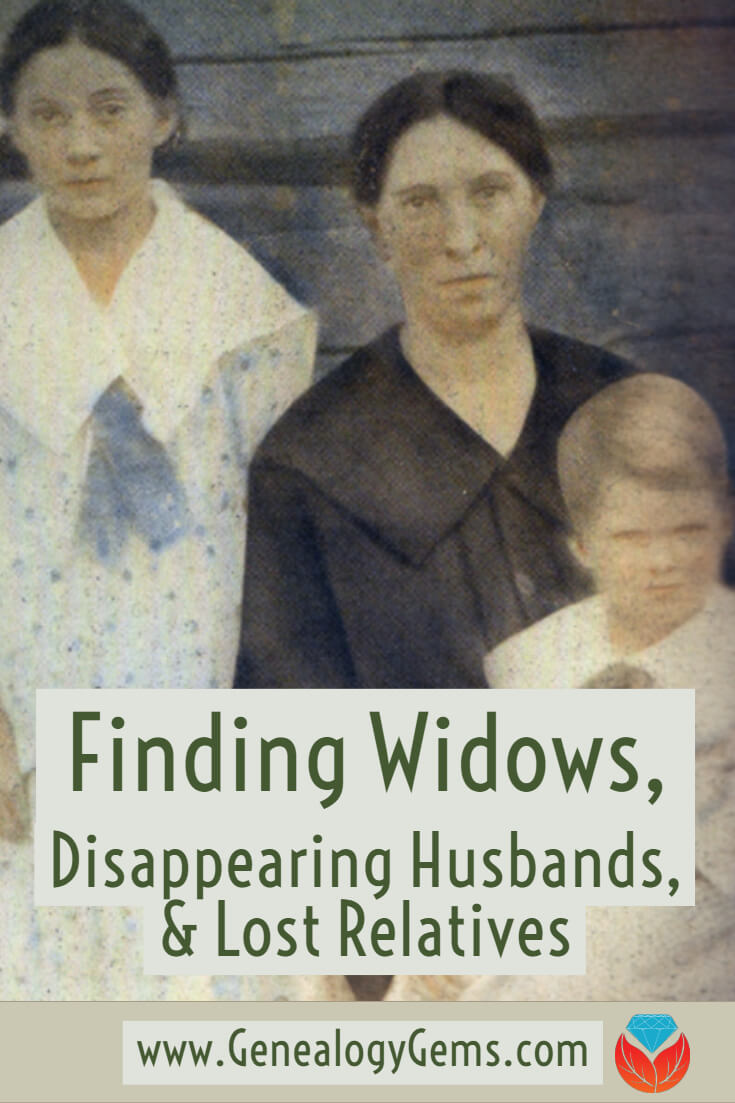
Widow or Not?
Genealogy Gems reader, Mary, wrote us the following comment:
“My grandmother Kitty’s first husband was Robert Lee Jeffries. They married in 1887 and had 4 or 5 children. He died in the very early 1900’s. She later remarried my grandfather, John, and they had four children together. All this took place in Hardin County, Kentucky. I cannot find when, where, or how her first husband died, or where he is buried. Can you help me?”
I think we can give Mary some tips to help her find Robert. As you read along, consider how these same tips and techniques could help you in finding widows, disappearing husbands, and lost relatives.
Finding Death Records in the Early 1900s
A death record is typically a good way to determine where someone went. If you can locate a death record for your lost individual, they aren’t lost anymore! Finding death records for the time period that Mary is asking about isn’t usually too difficult, unless there has been a record loss for that county. By doing a quick check on FamilySearch wiki for Hardin County, Kentucky, I learned that many records between 1852 and 1911 are missing, including some of the death records. That may be why Mary wasn’t able to find one.
When a death record can’t be found, there are many alternatives that we can exhaust. Cemetery records, newspaper obituaries, and probate records are just a few suggestions. But before we move into alternative records, something caught my attention.
Misspelled Names
With a last name like “Jeffries,” there could be several ways to spell it. Jeffrys, Jefferies, Jeffres, and perhaps many more. What can you do when you have a name, first or last, that could be spelled so many different ways?
One suggestion is to search by each of the possible name spellings, but another tool is to use an asterisk or wildcard. The first part of the surname Jeffries is always the same: J e f f. Whether you are searching records at Ancestry, Findmypast, or MyHeritage, you can use an asterisk after the last “f” to indicate you are looking for any of the possible surname spellings.
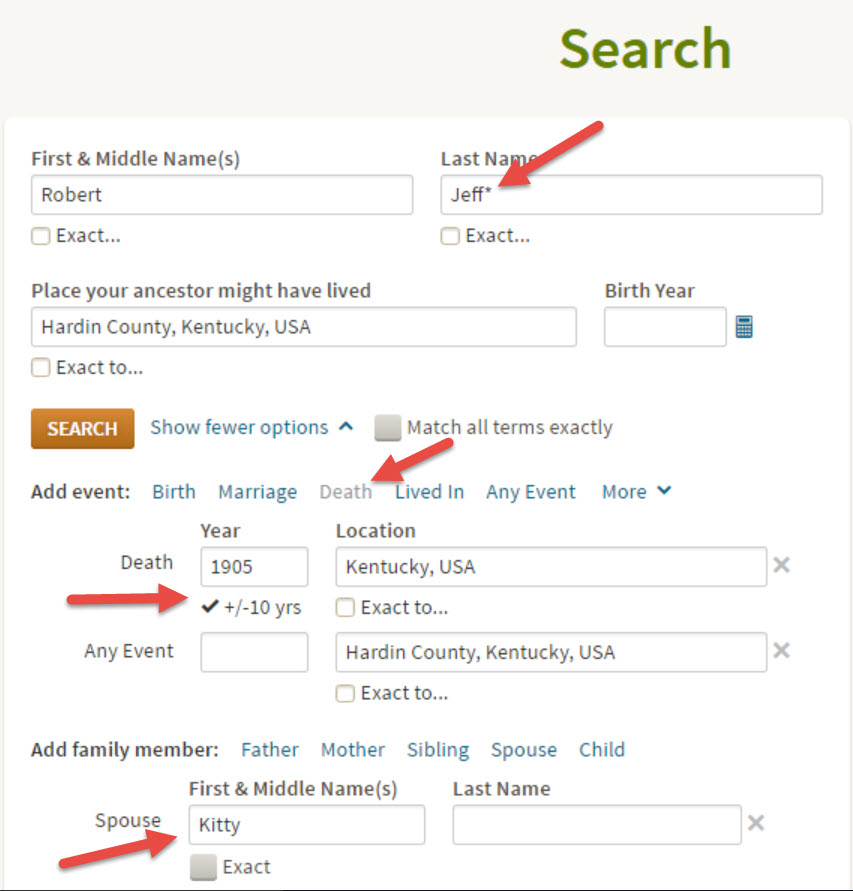
I didn’t find any great matches using the criteria you see in the image above, but I took off the death date range and Kitty’s name and found Bob Lee JeffERies living in his parents home in 1880 in Hardin County, Kentucky. Take a close look at this image:

Do you see the mistake? If you look at the digital image of the census, it spells the surname as Jeffries, however the record is indexed as Jefferies. Not to mention that Robert Lee is recorded as Bob Lee. This combination of name differences will always cause a little hiccup in our search process. This is why it is so important to consider name spellings when searching for records.
Even though using an asterisk didn’t produce a death record, you can see how using a tip like this can help when searching for any records online.
Alternatives to Death Records
Like I mentioned before, Hardin county had some record losses. Just because their death records may have been lost or destroyed, doesn’t mean the probate records were.
Using FamilySearch.org, I used the browse option to search probate record books in Hardin county, Kentucky. I found a record dated 25 Apr 1893, in which Kitty wrote her own will. [1] She mentions Lucy (possibly Robert’s mother found in the 1880 census) and others by name. What is strange is there’s no mention of a husband. I wondered if perhaps husband Robert had died before 1893. Unfortunately, there was no Robert Jeffries (or any variation) in the previous record books and the record book that Kitty appeared in was the last one available online.
When no will can be found, that doesn’t mean there is not a probate record available. The next step would be to visit the Hardin County probate office or State Archives to see if there is an estate packet available for Robert.
An estate packet is typically filled with all sorts of genealogy goodies! Receipts, list of heirs, and affidavits may shed light on many a burning question for your targeted ancestor.
The Disappearing Husband
Sadly, not all husband’s leave their families due to their demise. In the past, it was sometimes easier and more appealing to call yourself a widow or widower when your spouse left you. Kitty wrote a will in 1893 and did not mention a husband. In 1900, she was living in her father’s house and her children were divided up among the relatives, including her in-laws. Could Robert have left Kitty and the children? There may only be one way to know for sure.
Kitty remarried. To do that, either Robert had to die or she would need to be divorced. Divorce records can sometimes be located on a county level or at a state archives. I gave Hardin County Clerk of Courts a call and found out that divorce records between the years of 1804 -1995 are held at the Kentucky Department of Libraries and Archives. Their website provided details to ordering several types of records, including divorce records.
Looking in All the Wrong Places
Sometimes, we are so focused on one area that we can’t see past the end of our noses! Many of our ancestors lived on the borders of other counties. Hardin County, Kentucky is especially unique. It borders not only eight other Kentucky counties, but it also borders Harrison County, Indiana. It’s always a good idea to branch out to these nearby locations when you are having trouble locating records.
A Re-cap
When struggling to find a record for any targeted ancestor, try the following:
- Consider alternate name spellings and search for common nicknames.
- When there has been a possible record loss, search for alternative records that may hold the information you are looking for.
- Determine which counties/states your targeted location is bordering and search there for records as well.
Have you found a disappearing person or long, lost relative? If so, share with us (in the comment section below) your story and how you finally tracked the elusive person down. Maybe your story will help others still searching for that missing ancestor!
More Gems on Finding Missing Ancestors
How to Search Your Ancestors’ Other Spouses and Children
6 Sources that May Name Your Ancestors’ Parents
How to Save Time and Find the Ancestors You Are Looking For
Article References
(1) “Kentucky, Probate Records, 1727-1990,” digital images online, FamilySearch (www.familysearch.org : accessed 10 Aug 2016); record for Kitty A. Jeffries, 1893; citing Will Records, Index, 1893-1915, Vol. G, page 12.
Looking for a Living Relative?
Join Lisa Louise Cooke of The Genealogy Gems Podcast as she reveals 9 strategies to find your living relatives. Unleash your inner private eye and discover the tools that will help you connect with long lost cousins who may just hold the key to your genealogy brick wall!
This video class is part of Genealogy Gems Premium eLearning and includes a downloadable handout. Members can click here to watch right now. (Not a member? Click here to sign up!)
Disclosure: This article contains affiliate links and Genealogy Gems will be compensated if you make a purchase after clicking on these links (at no additional cost to you). Thank you for supporting Genealogy Gems!
This article was originally posted on August 24, 2016 and updated on April 18, 2019.
Listen to the Genealogy Gems Premium Podcast on Android Devices
FOR ANDROID USERS: How to Get the Premium Feed on Your Android Mobile Device
 Recommended app: Podcast Addict for Android, available in the Google Play Store.
Recommended app: Podcast Addict for Android, available in the Google Play Store.
Follow these steps to set up the Premium Podcast using the Podcast Addict app for Android. Examples shown below are on a tablet, so keep in mind that it may look slightly different on your device.
1. Download the Podcast Addict App

Podcast Addict app

Google Play Store
On your device, go to the Google Play Store and download the Podcast Addict app.
(*Note: If you’ve never used the Google Play store you may be required to set up an account, including payment information. This is unrelated to Genealogy Gems, but necessary in order to download apps from the Google Play Store.)
Recommended app: Podcast Addict for Android, available in the Google Play Store.
Follow these steps to set up the Premium Podcast using the Podcast Addict app for Android.
NOTE: Examples shown below are on a tablet, so keep in mind that it may look slightly different on your device.
2. Add the Genealogy Gems Premium Podcast Feed
Tap the + icon to add a feed

Tap “RSS Feed, YouTube/Twitch Channel, Soundcloud URL”

In the “RSS feed URL” field, copy and paste this address to ensure it is exactly correct with no extra spaces at the end (the feed address is case sensitive):
https://lisalouisecooke.com/Premium_Feed/feed.xml
- Check the box for “Authentication (Premium Podcast)”
- Type in your Genealogy Gems Premium Membership username and password. You MUST use your membership username, NOT your email address.
- Tap “Add”

Your Podcast home screen will now have the Genealogy Gems Premium Podcast.

Tap the podcast icon. It may appear yellow like this or it may be our logo) to reveal all episodes, starting with the most recent episode at the top of the list.
3. Downloading Episodes
You can download episodes so that you can listen offline, without an internet connection or using your device’s cellular data. Download an episode by tapping the down arrow icon on the right:
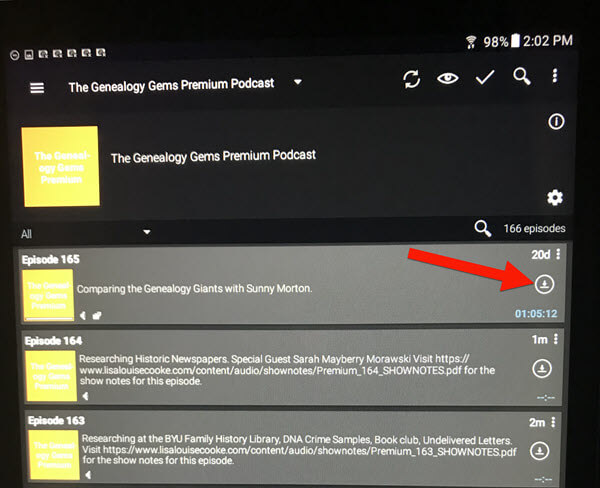
Once the episode is downloaded, a play button will appear that you can click to listen. A small download icon will appear indicating that this episode is downloaded to your device:
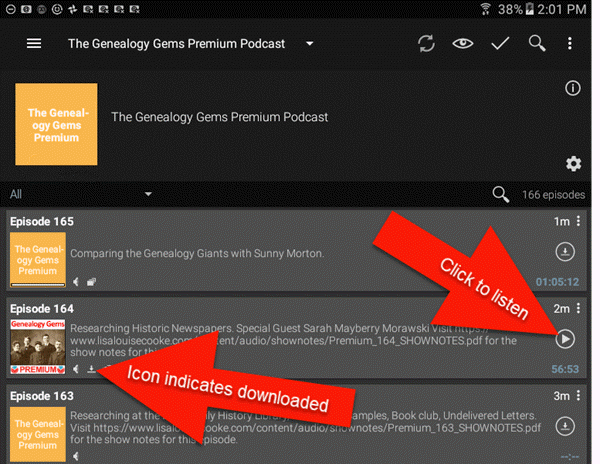
3. Listening to Episodes & Viewing Show Notes
When you open the app, tap the Genealogy Gems Premium podcast to access episodes:
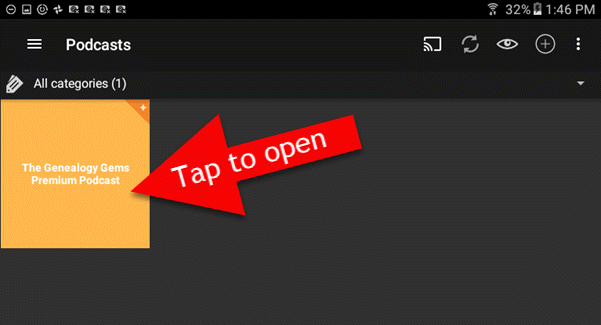
You can go straight to the episodes you’ve already downloaded through the app’s menu. Tap the three lines icon:
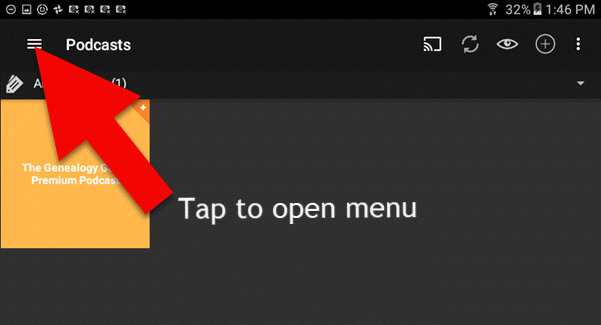
Then tap Downloaded episodes:
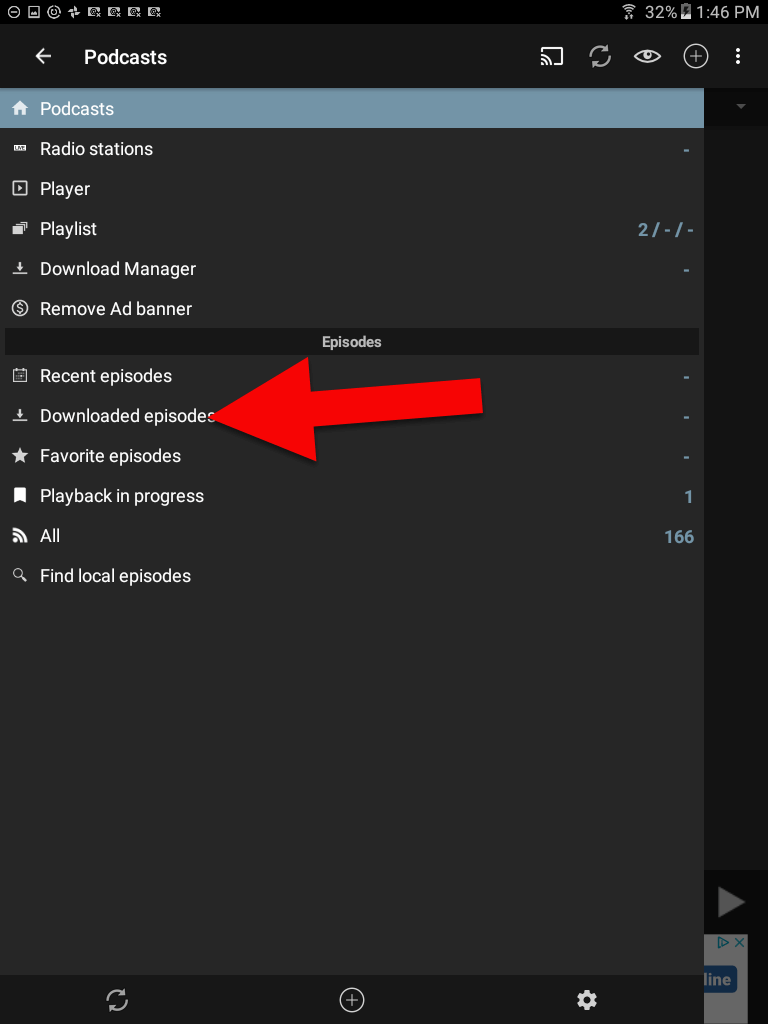
On this screen are only the episodes you have downloaded for offline listening. To return to all episodes just tap the 3 line icon in the upper left corner.
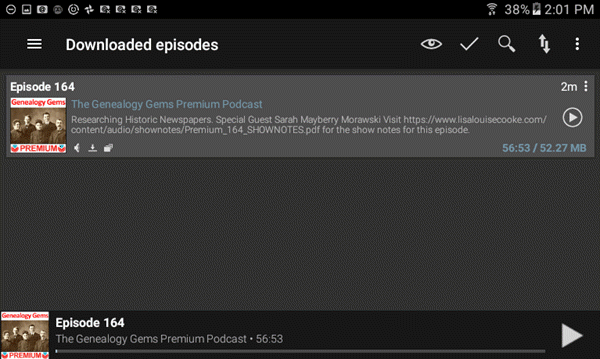
4. Deleting Downloaded Episodes
After you have listened to a downloaded episode, you can delete it to free up the space on your device. (Don’t worry, all of the episodes are still available through the main podcast feed in Podcast Addict.) To delete an episode in the Downloaded Episodes area, tap the 3 dots icon on the episode you want to delete:
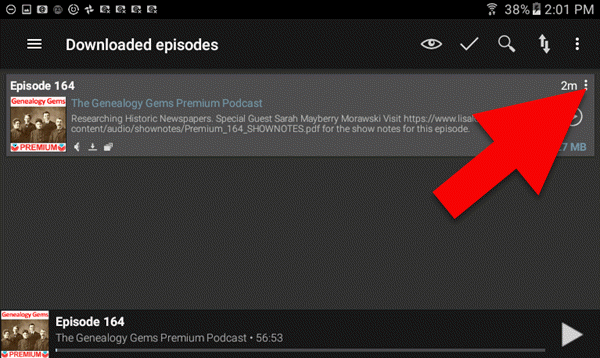
(Note: If you want to delete all the episodes that you’ve already played, click the 3 dots icon at the very top of the right-hand corner, and then tap “Delete Played Episodes”)
On the page for that downloaded episode tap the trash can icon to delete it from your device:

Need More Help?
If you’re experiencing error messages or other technical difficulties, please visit our Premium eLearning FAQ page and head to the Troubleshooting section towards the bottom. You’ll find answers to the most common causes of problems and solutions and tips to fix them.
